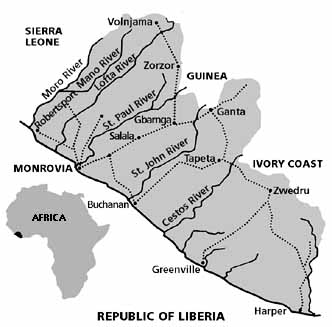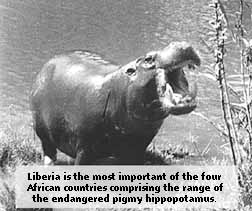






Saving Liberia's Rainforests
Conservation efforts are almost always after the fact: after the damage
is done, when true restoration is difficult or impossible, and one can only
preserve what little is left.
One group is working to stop damage to Liberia's rainforests before it happens!
by Karla Stang
 ave the rainforest" is a now-familiar phrase. We
see it on bumper stickers, T-shirts, and posters. But where are the rainforests?
And what is actually being done to save them?
ave the rainforest" is a now-familiar phrase. We
see it on bumper stickers, T-shirts, and posters. But where are the rainforests?
And what is actually being done to save them?
 Alexander L. Peal, the founder and chairman of the Society
for the Renewal of Nature Conservation in Liberia (SRNCL), offers some answers.
Peal is from the war-torn country of Liberia, which contains one of the
last tropical rainforests in West Africa. Considering the degree of deforestation
in neighboring countries, Liberia is a present-day refuge.
Alexander L. Peal, the founder and chairman of the Society
for the Renewal of Nature Conservation in Liberia (SRNCL), offers some answers.
Peal is from the war-torn country of Liberia, which contains one of the
last tropical rainforests in West Africa. Considering the degree of deforestation
in neighboring countries, Liberia is a present-day refuge.
 The spectacular biodiversity of Liberia is clearly worth
protecting: the forest supports 568 species of birds, 9 of which are endangered,
as well as a wide range of plant and animal life. The forest is a unique
ecological niche for several rare species, such as the white-breasted guinea
fowl, Jentink's duiker (a deer-like creature, the rarest in the world),
pygmy hippopotamus, Diana monkey and Liberian mongoose. Additional animal
populations include the giant forest hog, chimpanzees, red colobus (a long-tailed
monkey), bongo antelope, leopard and the golden cat.
The spectacular biodiversity of Liberia is clearly worth
protecting: the forest supports 568 species of birds, 9 of which are endangered,
as well as a wide range of plant and animal life. The forest is a unique
ecological niche for several rare species, such as the white-breasted guinea
fowl, Jentink's duiker (a deer-like creature, the rarest in the world),
pygmy hippopotamus, Diana monkey and Liberian mongoose. Additional animal
populations include the giant forest hog, chimpanzees, red colobus (a long-tailed
monkey), bongo antelope, leopard and the golden cat.
 In the early 70s, Peal was a member of the forestry
assigned to one of the richest areas in the forest in terms of animal life.
When Peal realized that the survival of certain animals was threatened due
to hunting and deforestation, he decided to get involved in wildlife management.
He learned that there was no existing conservation program, so he created
one from scratch - the Society for Nature Conservation in Liberia (SNCL).
In the early 70s, Peal was a member of the forestry
assigned to one of the richest areas in the forest in terms of animal life.
When Peal realized that the survival of certain animals was threatened due
to hunting and deforestation, he decided to get involved in wildlife management.
He learned that there was no existing conservation program, so he created
one from scratch - the Society for Nature Conservation in Liberia (SNCL).
 "We were given the challenge of educating both
the general public and government officials about the importance of nature
conservation," said Peal. Some native villagers were initially suspicious,
but when Dr. Phillip Robinson, a veterinarian for UCSD and a founding member
of the Board of Directors for SRNCL, explained that they were "wildlife
missionaries," it seemed to clear up confusion and mistrust.
"We were given the challenge of educating both
the general public and government officials about the importance of nature
conservation," said Peal. Some native villagers were initially suspicious,
but when Dr. Phillip Robinson, a veterinarian for UCSD and a founding member
of the Board of Directors for SRNCL, explained that they were "wildlife
missionaries," it seemed to clear up confusion and mistrust.
 Despite the chaotic political climate of the 1980s,
nature conservation was on the upswing in Liberia. SNCL created extensive
educational programs through the schools and media to teach the general
public about protecting and conserving the environment. Other achievements
included the establishment of the first national park in Liberia, membership
in international conventions and organizations, and the development of close
bilateral working relationships with several multi-national institutions
and organizations.
Despite the chaotic political climate of the 1980s,
nature conservation was on the upswing in Liberia. SNCL created extensive
educational programs through the schools and media to teach the general
public about protecting and conserving the environment. Other achievements
included the establishment of the first national park in Liberia, membership
in international conventions and organizations, and the development of close
bilateral working relationships with several multi-national institutions
and organizations.

Fortunes of war
 Civil war from 1989 through 1992 destroyed many of Liberia's
institutions, including the new conservation programs. Some of the national
park staff members were killed, and others left the area at onset of the
fighting.
Civil war from 1989 through 1992 destroyed many of Liberia's
institutions, including the new conservation programs. Some of the national
park staff members were killed, and others left the area at onset of the
fighting.
 "It was difficult, because we thought we had made
so much progress, and then our dreams were literally smashed right in front
of our eyes," said Peal. "But then I remembered the importance
of what we were doing - and the lasting benefits. So I don't mind the setbacks
or the sacrifice of my time."
"It was difficult, because we thought we had made
so much progress, and then our dreams were literally smashed right in front
of our eyes," said Peal. "But then I remembered the importance
of what we were doing - and the lasting benefits. So I don't mind the setbacks
or the sacrifice of my time."
 There are still ongoing skirmishes and fighting in some
areas of Liberia, and the government is very unstable. There is a peace-keeping
force and transitional government in place, and people are searching for
a peaceful solution, but efforts at conservation have not been a political
priority.
There are still ongoing skirmishes and fighting in some
areas of Liberia, and the government is very unstable. There is a peace-keeping
force and transitional government in place, and people are searching for
a peaceful solution, but efforts at conservation have not been a political
priority.
 Peal relocated to the United States at the onset of
the civil war to create the "renewal" of the SNCL, in 1992. Peal,
Robinson, additional board members and volunteers have worked for the past
two years in the United States and abroad to gather support for conservation
in Liberia once the fighting stops and the new government is in place. When
peace is restored to the country, organized reconstruction of the conservation
program will need to take place at all levels - a grand effort, considering
the country's limited resources.
Peal relocated to the United States at the onset of
the civil war to create the "renewal" of the SNCL, in 1992. Peal,
Robinson, additional board members and volunteers have worked for the past
two years in the United States and abroad to gather support for conservation
in Liberia once the fighting stops and the new government is in place. When
peace is restored to the country, organized reconstruction of the conservation
program will need to take place at all levels - a grand effort, considering
the country's limited resources.

A fresh start
 The new government's first priority will be to improve
the economy. SRNCL has the foresight to be organized and ready to insist
on including conservation in the overall reconstruction.
The new government's first priority will be to improve
the economy. SRNCL has the foresight to be organized and ready to insist
on including conservation in the overall reconstruction.
 "We fear that too much pressure will be exerted
on the forest and other natural resources to provide economic development,
so we want to be right there with the new leaders to stress the importance
of what we're doing," said Peal. "But the SRNCL is a non-political
group - we don't know who will be in power, and we don't want to alienate
anyone by taking sides."
"We fear that too much pressure will be exerted
on the forest and other natural resources to provide economic development,
so we want to be right there with the new leaders to stress the importance
of what we're doing," said Peal. "But the SRNCL is a non-political
group - we don't know who will be in power, and we don't want to alienate
anyone by taking sides."
 Evelyn Hightower, the treasurer of SRNCL, was traveling
through Liberia as an 'ecotourist' when she met Peal and became interested
in SRNCL. "I traveled to the neighboring countries and saw with my
own eyes how the desert is encroaching into the forest because of deforestation...
and then I understood why it's so necessary to preserve the small area of
rainforest that is left," Hightower said.
Evelyn Hightower, the treasurer of SRNCL, was traveling
through Liberia as an 'ecotourist' when she met Peal and became interested
in SRNCL. "I traveled to the neighboring countries and saw with my
own eyes how the desert is encroaching into the forest because of deforestation...
and then I understood why it's so necessary to preserve the small area of
rainforest that is left," Hightower said.
 The SRNCL's current objectives include: educating the
general public in the United States and abroad about the need for conservation,
protecting endangered and rare wildlife species and ecosystems in Liberia,
organizing staff training programs for the Liberian Wildlife and National
Parks Division, restoring or replacing damaged or lost equipment and materials
at Sapo National Park, raising funds from charitable donations, and securing
grants from individuals, foundations and corporations. SRNCL holds public
meetings, conducts film shows and discusses conservation issues on the local
radio and press. SCNL also promotes nature clubs at schools and publishes
a newsletter for its members.
The SRNCL's current objectives include: educating the
general public in the United States and abroad about the need for conservation,
protecting endangered and rare wildlife species and ecosystems in Liberia,
organizing staff training programs for the Liberian Wildlife and National
Parks Division, restoring or replacing damaged or lost equipment and materials
at Sapo National Park, raising funds from charitable donations, and securing
grants from individuals, foundations and corporations. SRNCL holds public
meetings, conducts film shows and discusses conservation issues on the local
radio and press. SCNL also promotes nature clubs at schools and publishes
a newsletter for its members.
 SRNCL's foresight is unique. The concept is to protect
a fragile environment before emerging economic and political forces damage
natural resources, instead of trying to fix after-the-fact environmental
problems like pollution and deforestation. And despite continuing civil
strife, most Liberians agree on the need to protect and conserve their common
ground.
SRNCL's foresight is unique. The concept is to protect
a fragile environment before emerging economic and political forces damage
natural resources, instead of trying to fix after-the-fact environmental
problems like pollution and deforestation. And despite continuing civil
strife, most Liberians agree on the need to protect and conserve their common
ground.

Karla Stang is an editor for the Times-Advocate in Escondido, an environmental
reporter, and a freelance writer. Raised in Hemet, CA, she moved to San
Diego 6 year ago and now lives in Golden Hill.







